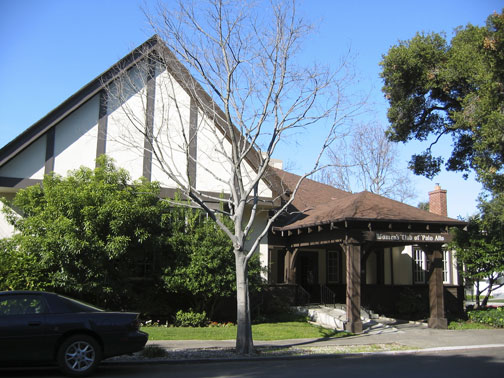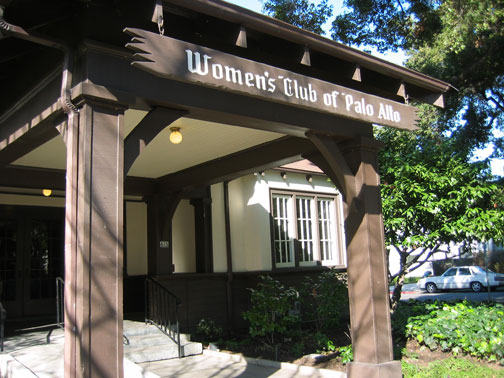 Palo Alto Stanford Heritage
Palo Alto Stanford Heritage 
When people stroll past the handsome Tudor Craftsman building at 475 Homer Avenue, they wonder, “What goes on in there anyway?" Since 1916, this building has been home to The Woman’s Club of Palo Alto. The origins of the Club, however, go back 109 years.
On June 20, 1894, 24 women gathered at the old Presbyterian Church to formally organize a club for women. Their goals were friendship, community involvement and self–improvement. Mary Grafton Campbell, a doctor and foster mother to 13 children, was elected President. She congratulated Palo Alto on “no longer being a sort of half orphan, since it now has City Mothers as well as City Fathers, thus ensuring the better nature” of the city. Campbell and her cohorts molded the character of their pioneer town. Anna Zschokke, The Mother of Palo Alto Schools, provided the statistical data which enabled the establishment of the Palo Alto Unified School District. In 1897, she personally financed the first high school buildings. Julia Gilbert, The Mother of Palo Alto Libraries, formed a circulating library in 1898 which led, four years later, to the city’s first public library. Its shelves were filled with 2,300 books donated by the Woman’s Club. Collectively, the women of the Club fought hard for women’s rights achieving suffrage in California by 1911, nine years before the 19th amendment passed.
Members also dreamed of having their own Clubhouse. In 1904, they purchased a lot for $1,125 at the corner of Homer and Cowper. There was trepidation that this location was “too far out in the country”! The next 12 years saw incessant fund-raising through galas, food markets, costume parties, sell-out speakers such as Helen Keller and the publication of The Santa Clara Valley and a Woman’s Club Cook Book. In September 1916, a celebration for 400 townspeople was held at the finished Clubhouse which had cost $10,590 to build. The Palo Alto Times stated, “We believe the Woman’s Club is preparing to contribute a great deal to the future of the city.”
The architect chosen to design the Tudor Craftsman Clubhouse was Charles Edward Hodges (1866-1944). He emigrated from England in 1924 and worked as a draftsman for Charles Coolidge whose firm designed Memorial Church and the Arch. When Coolidge left, Hodges supervised the construction of these projects and soon became Stanford’s resident architect. University buildings sustained much damage in the 1906 earthquake and Hodges, whether deservedly or not, was blamed. Resigning from the University, he continued building in the Palo Alto area.
Hodges chose an eclectic Tudor Craftsman design for the Woman’s Club. The exterior has mainly Craftsman details: the porte-cochere is supported by large, square columns, heavy beams are supported by simple braces and rafter tails are seen under the gutters. The building has a stucco finish with a painted wood band of lap siding at the base. Tudor elements are evident only at the front with its one and a half story gable end, its half timbering and a steeply pitched roof.

Several interior details are noteworthy. The maple floored Ballroom, has fir board and batten on three sides. The fourth side boasts a stage with the only extant olio curtain in Palo Alto. These curtains were common in public spaces across the country and featured a center pastoral scene surrounded by ads for local businesses. The Club was paid $500 in 1926 to hang the curtain. Adjacent to the Ballroom is the Fireside Room with its unusual salt glazed tiles. These were produced in the 1910’s by the Steiger Terra Cotta and Pottery Company in South San Francisco.
The Palo Alto Woman’s Club deserves credit for preserving this charming Historic Inventory building. Even more notable is the enormous contribution that the women of the Club made to the history of Palo Alto and to the history of women throughout the country. ©
PAST, April 12, 2013
E-mail us at either webmaster@pastheritage.org or president@pastheritage.org.
![]() Palo Alto Stanford Heritage—Dedicated to the preservation of Palo Alto's historic buildings.
Palo Alto Stanford Heritage—Dedicated to the preservation of Palo Alto's historic buildings.
Copyright © 2015 Palo Alto Stanford Heritage. All rights reserved.